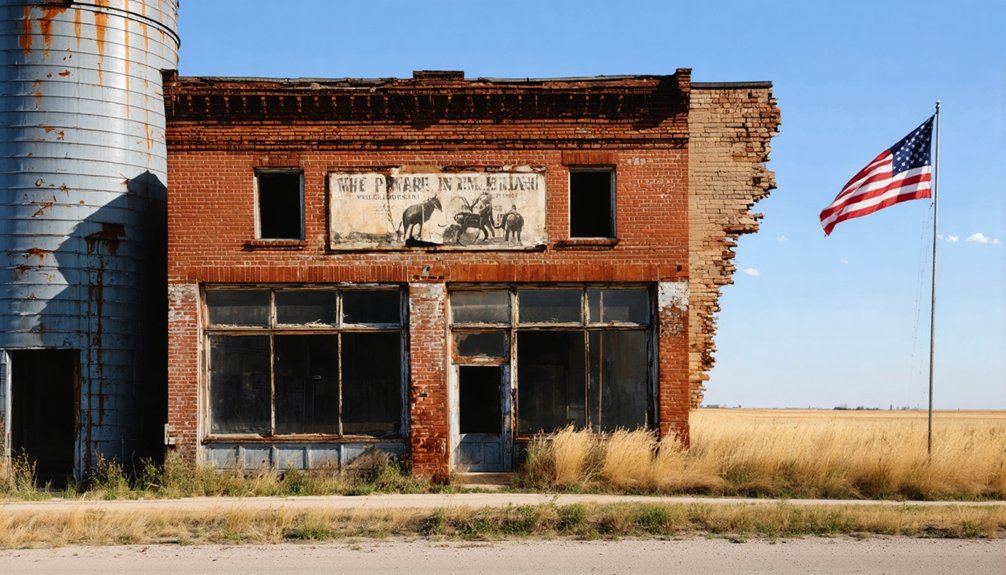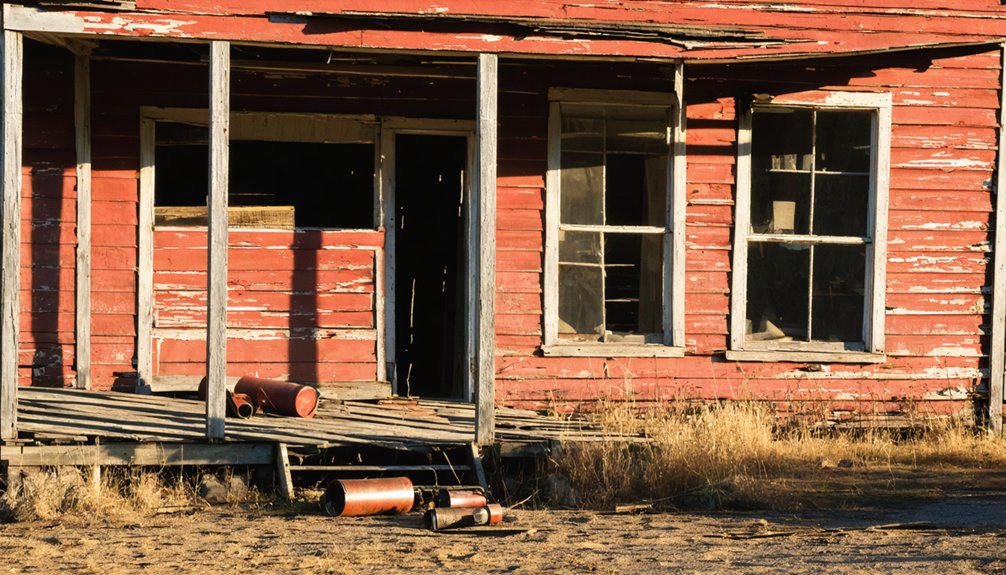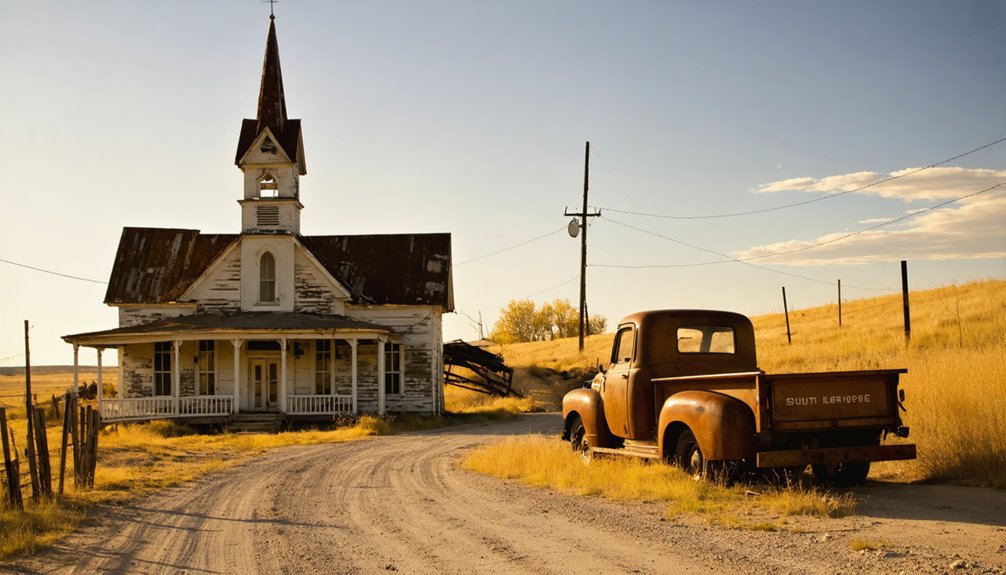You’ll find Tinton nestled 13 miles east of Deadwood in South Dakota’s Spearfish Canyon. Founded during the 1876 gold rush, this well-preserved ghost town reached its peak in the early 1900s with 300 residents and the world’s largest tin ore reduction mill. The company town thrived through both World Wars before declining in the 1950s. Now on the National Register of Historic Places, Tinton’s abandoned structures reveal fascinating stories of Black Hills mining life.
Key Takeaways
- Tinton is South Dakota’s most well-preserved ghost town, established during the 1876 gold rush in Spearfish Canyon near Deadwood.
- The town flourished as a company mining town, reaching nearly 300 residents and featuring the world’s largest tin ore reduction mill.
- Major mining operations focused on tin, gold, and lithium, with peak activity during World Wars I and II.
- The town was abandoned in 1959 following economic struggles and a devastating mill fire in 1953.
- Added to National Register of Historic Places in 2005, the site contains the largest collection of remaining structures among Black Hills ghost towns.
The Birth of a Mining Frontier Town
Like many Black Hills settlements, Tinton emerged during the 1876 gold rush when prospector Edgar St. John discovered promising ore deposits in the area.
You’ll find this frontier outpost nestled in Spearfish Canyon, just 13 miles east of Deadwood, where mining methods quickly evolved from simple prospecting to organized operations.
The community dynamics of early Tinton were shaped by its relationship with neighboring settlements, particularly Bear Gulch, which served as the region’s central hub from 1878 to 1903.
As mining operations expanded, the Dakota Tin and Gold Company established essential infrastructure, building shaft houses, cabins, and dams to support the growing workforce.
You can still imagine the bustling atmosphere as prospectors and miners carved out their piece of the American frontier in this rugged Black Hills terrain.
The discovery of tin deposits in the 1880s transformed the area’s mining focus and led to the formation of the Tinton Tin Mining Company by 1902.
Among the town’s amenities, residents enjoyed access to a general store and post office that served as central gathering places for the mining community.
Golden Days of Tin and Gold Mining
During the early 1900s, you’d find Tinton bustling with nearly 300 residents as the town’s tin and mineral operations reached their peak production.
You could witness the world’s largest tin ore reduction mill processing minerals while the Tinton Times newspaper kept miners and management informed of local developments.
The town’s mining operations gained renewed importance during World War I and II, when demand for tin and lithium soared, particularly with Tinton’s lithium oxide contributing to the Manhattan Project.
The town’s social life centered around the community hall building where up to 200 spectators could gather for events and celebrations.
Modern exploration continues in the area, with 428 mining claims now covering over 8,400 acres across South Dakota and Wyoming.
Thriving Early Mining Operations
When Edgar St. John discovered ore during the Black Hills Gold Rush, you’d never have guessed it would transform this quiet corner of South Dakota into a bustling mining hub.
By 1876, miners were already extracting gold using various mining techniques, but the real game-changer came in the 1880s with the discovery of tin lode deposits.
Despite labor challenges, two thriving communities – Bear Gulch and Forrest City – sprang up to support the expanding operations.
The area’s potential caught the eye of serious investors, leading to the formation of the Tinton Tin Mining Company in 1902.
Within a year, they’d established a proper company town complete with all the amenities miners needed: a mercantile, bank, school, hotel, and a state-of-the-art ore reduction mill.
Wartime Economic Boom
The economic landscape of Tinton shifted dramatically as World War II approached. The town’s strategic importance soared when Japan’s control of global tin supplies made domestic production essential.
You’d find Tinton’s mines bustling with activity as they shifted to wartime production, extracting critical materials like lithium oxide for the Manhattan Project, along with feldspar and tin.
Despite the War Production Board‘s restrictions on gold mining, Tinton’s economic fluctuations during this period reflected both opportunity and challenge.
With a peak population of 300 company residents, Tinton became a significant wartime industrial hub focused on strategic mineral production.
While the mine’s contribution to the war effort kept operations running, the financial struggles persisted. The town experienced a brief surge of activity, but post-war conditions proved difficult to overcome.
These wartime years marked a pivotal chapter in Tinton’s story, showcasing its role in America’s industrial might.
Life in a Company-Built Community
Life in Tinton revolved around the company’s thoughtful design of worker housing, with bachelor miners occupying boarding houses while families settled into separate cottages.
You’d find a well-structured social hierarchy typical of Black Hills mining towns, where company managers lived in the best homes while laborers resided in more modest dwellings.
Your daily routine would’ve centered on the mining operations, with the town’s mercantile, post office, and school providing essential services between work shifts.
Operations at what was once the largest tin mine in the world drove the community’s development and prosperity.
Company-Built Housing Design
Living in Tinton’s company-built housing meant adapting to a strictly controlled residential environment designed by the Tinton Tin Mining Company.
You’d find company influence evident in every aspect of housing design, from the strategic placement of buildings near work sites to the tiered system of accommodations based on your family status.
If you were a single miner, you’d be assigned to one of the communal boarding houses, while families received separate cottages. The wooden structures, though modest, were built to withstand harsh Black Hills winters.
Housing locations prioritized efficiency and proximity to essential services like the mercantile, bank, and mill. You couldn’t choose your architectural style or location – these decisions reflected the company’s focus on operational efficiency rather than personal preference.
Daily Life and Work
Working in Tinton meant your daily routine revolved entirely around the mining operations that dominated this Black Hills company town. You’d join roughly 300 fellow workers handling physically demanding tasks with mining equipment – from shaft mining and tunnel work to operating the ore reduction mill.
Your life centered around company-controlled employment, whether you’re extracting gold, tin, lithium, or tantalum. Worker safety wasn’t a prominent concern in those days.
The company provided your basic needs through their mercantile store, bank, and company housing. When you weren’t underground or at the mill, you might catch up on local news in the Tinton Times or participate in informal community gatherings.
During World War II, you’d have shifted from gold mining to producing strategic minerals for the war effort, including materials for the Manhattan Project.
Mining Town Social Structure
While many mining towns developed organically, Tinton’s social structure emerged from careful company planning that divided its 300 residents into distinct classes.
You’d find company executives and managers at the top, living in separate, more comfortable housing. Below them, engineers and geologists occupied specialized positions with designated company quarters. Skilled workers and foremen filled the middle ranks, while unskilled laborers made up the majority.
Despite rigid class divisions, you’d see daily interactions at community hubs like the Tinton Times newspaper office, the two-room schoolhouse, and the company mercantile.
The stagecoach’s tri-weekly arrival brought everyone together, and the post office served as a meeting point where social mobility seemed possible, if only briefly, through shared experiences and commerce.
Wartime Impact and Economic Decline

Although Tinton had faced economic challenges since the 1910s, World War II dealt the town its most devastating blow.
World War II delivered the fatal strike to Tinton, a town already weakened by decades of economic hardship.
You’ll find that wartime regulations forced the closure of gold mining operations, while labor shortages crippled the remaining mineral production. Even W.O. Fillmore’s Dakota Tin and Gold Company, established in 1937, couldn’t overcome these obstacles.
The town’s struggles intensified when a devastating mill fire in 1943 destroyed critical infrastructure.
Despite brief attempts to revive tin mining during the war, these operations proved unprofitable. You can trace Tinton’s final decline through the 1953 mill fire and its ultimate abandonment in 1959.
While Tinton Enterprises continues limited mining today, the once-bustling mining town stands as a symbol of how wartime pressures and economic shifts can reshape a community’s destiny.
Architectural Legacy and Nature’s Return
Despite decades of abandonment, Tinton stands as South Dakota’s most well-preserved ghost town, with more surviving structures than any other abandoned mining settlement in the state.
You’ll find homogeneous building materials throughout the remaining structures, reflecting the efficient company town design that once supported the mining operations.
Nature’s steady march continues to reshape Tinton’s landscape. The surrounding forest creeps closer to the deteriorating buildings, while harsh weather and a devastating 2018 tornado have accelerated the architectural decay.
Many structures now lack roofs, and fallen trees litter the grounds. Wildlife, including crows and coyotes, have made this their home.
While Tinton Enterprises continues mining operations for tantalum nearby, they’ve restricted access to protect both the historic structures and visitors from the hazards of nature’s reclamation.
Historical Preservation and Cultural Impact

Since its addition to the National Register of Historic Places in 2005, Tinton’s five-acre Dakota Tin and Gold Mine site stands as a tribute to Black Hills mining heritage.
While you’ll find the largest collection of remaining structures among Black Hills ghost towns here, preservation challenges mount as roofs collapse and nature reclaims the landscape.
The site’s cultural significance extends beyond its crumbling walls. In the 1960s, former residents gathered for annual reunions, maintaining their connection to this once-thriving mining community.
Today, while Tinton Enterprises restricts access to protect the site, photographs and documentaries by SDPB keep the town’s legacy alive.
The property represents more than abandoned buildings – it’s a reflection of the economic shifts and social changes that defined Black Hills mining communities.
Frequently Asked Questions
Are There Any Paranormal or Supernatural Reports From the Abandoned Town?
You’ll find empty buildings but no documented ghost sightings in this mining town. Despite its eerie atmosphere and local legends, there’s no credible evidence of supernatural activity in the ruins.
What Wildlife Species Now Inhabit the Old Buildings and Surrounding Area?
You’ll spot coyotes, bobcats, and deer using buildings for shelter, while various birds nest in the ruins. Wildlife sightings confirm species adaptation, with bats and small mammals occupying every abandoned corner.
Can Metal Detecting Be Done Legally Within Tinton’s Boundaries?
You’ll need specific permits for metal detecting in Tinton due to federal and state treasure hunting legality restrictions. It’s prohibited near historic structures and mining claims without proper authorization.
Were Any Notable Crimes or Mysteries Associated With Tinton’s History?
Want to know about Tinton’s dark past? You won’t find any. Historical records show no unsolved disappearances or notable crimes during the town’s active years – just typical mining town economic struggles.
What Happened to the Mining Equipment and Machinery After Abandonment?
You’ll find Tinton’s mining legacy mostly abandoned in place – equipment deterioration took its toll after a devastating 1943 mill fire, with machinery left to rust, scavenged by others, or destroyed by neglect.
References
- https://www.historynet.com/ghost-town-tinton-south-dakota/
- https://kids.kiddle.co/Tinton
- https://www.sdpb.org/arts-and-culture/2018-07-25/ghost-towns-of-south-dakota-tinton
- https://westernmininghistory.com/towns/south-dakota/tinton/
- https://www.youtube.com/watch?v=jEZL_GLyfck
- https://hikearizona.com/decoder.php?ZTN=21630
- https://en.wikipedia.org/wiki/Tinton
- https://dakotagoldcorp.com/portfolio/explore-our-gold-properties/tinton-property/
- https://westernmininghistory.com/mine-detail/10275020/
- https://dakotagoldcorp.com/community/esg-overview/



